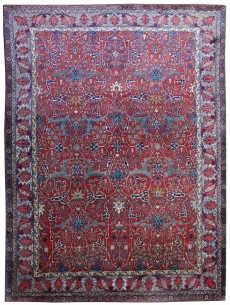 Tehran is the capital of Iran located in the north central area of the country at the base of Elburz Mountains. It was designated the capital city by Agha Mohammad Khan around two centuries ago. Since then the city has grown from being a small provincial town to a major metropolis with 12 million inhabitants.
Tehran is the capital of Iran located in the north central area of the country at the base of Elburz Mountains. It was designated the capital city by Agha Mohammad Khan around two centuries ago. Since then the city has grown from being a small provincial town to a major metropolis with 12 million inhabitants.
Tehran Rugs: History and Current Market Status
The Tehran weaving industry was buoyed the popularity of Persian rugs and carpets in international markets. The rugs and carpets produced in Tehran tend to have a curvilinear design and pattern. The rugs now available are mostly 50 years old and up and are now difficult to find. They are now only woven by master-weavers for affluent buyers or to be showcased at worldwide museums.
Rassam Arabzadeh, a master-rug-weaver of Iran has played an important role in the increasing popularity of these rugs and carpets. His designs are considered to be the best among all of Tehran rug designs. The quality of material used in the production of these rugs varies based on the time of their production. Earlier versions of Tehran rugs were good but were limited somewhat due to coarse raw materials and improper tools. Rugs produced today by master-weavers are excellent and that is why they have high export prices.
Today, Tehran rugs are made from soft wool with tight pile weaving and they are comparatively thinner than other Persian carpets. The warps of these rugs and carpets are mostly of cotton with either woolen or cotton wefts. Persian knots are used for weaving of the Tehran rugs and carpets. They most commonly use dark red tones with blue shades and ivory accents. There is also use of soft green and brown color tones. They are available in different shapes and sizes ranging from medium size of 4×6 feet to large room-sized of 10×18 feet.